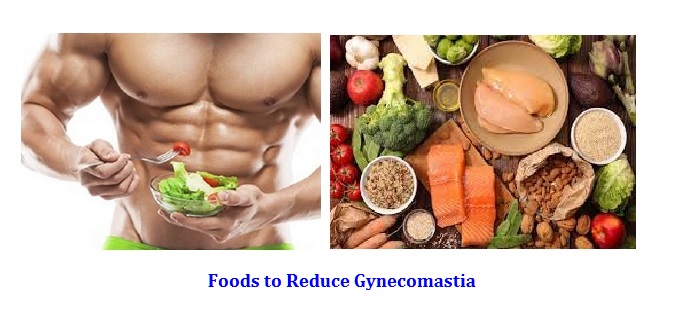The specific foods to reduce gynecomastia include cruciferous vegetables, flaxseeds and flaxseed oil, nuts, fish, fruits, and whole grains. You should eat them along with other foods to get your recommended daily nutrients.
Explore how they work to reduce gynecomastia and how to add them to your diet.
Gynecomastia, or the enlargement of breast tissue in males, can be a source of discomfort and self-consciousness. While there are medical treatments available for severe cases, dietary changes can also be an effective way to reduce gynecomastia.
In this article, we will discuss specific foods to reduce excessive male breast tissue, as well as the science behind how these foods work to combat this condition. We will also provide some meal ideas and lifestyle tips to help reduce the symptoms of gynecomastia naturally.
Foods to reduce gynecomastia at home

- Cruciferous vegetables such as broccoli, cauliflower, kale, and cabbage
- Flaxseeds and flaxseed oil
- Nuts such as almonds, walnuts, and peanuts
- Fish such as salmon, tuna, and mackerel
- Fruits such as citrus fruits, strawberries, and blueberries
- Whole grains such as brown rice, whole-wheat bread, and quinoa
Cruciferous vegetables can reduce gynecomastia
Cruciferous vegetables such as broccoli, cauliflower, kale, and cabbage are rich sources of phytochemicals that can help reduce gynecomastia. Here is a breakdown of how each of these vegetables that reduce gynecomastia works:
Broccoli
Broccoli contains compounds called indole-3-carbinol (I3C) and sulforaphane, which reduce estrogen levels and increase testosterone levels in men. I3C helps to convert estrogen into a less potent form, while sulforaphane increases the activity of enzymes that break down estrogen.
Cauliflower
Cauliflower also contains I3C, which promotes a healthy balance of estrogen and testosterone in men. Additionally, cauliflower contains compounds called glucosinolates, which can help reduce inflammation in the body.
Kale
Kale is a rich source of vitamins and minerals, as well as compounds called flavonoids. Flavonoids contain antioxidant and anti-inflammatory properties, and they can help reduce the activity of aromatase, an enzyme that converts testosterone into estrogen.
Cabbage
Like broccoli and cauliflower, cabbage contains compounds that can help regulate estrogen levels in men. Cabbage is also a good source of fiber and vitamin C, which can help support overall health and reduce inflammation.
Incorporate Cruciferous Vegetables into Your Diet to Reduce Moobs
Steam or roast vegetables: Steaming or roasting cruciferous vegetables can help preserve their nutrients and flavor. You can season them with herbs and spices to enhance the taste.
Add vegetables to salads: Adding raw or lightly cooked cruciferous vegetables to your salad is an easy way to get more of these nutrient-dense foods into your diet.
Use vegetables as a side dish: Steamed or roasted cruciferous vegetables make a great side dish for any meal. You can season them with salt and pepper or try adding lemon juice or balsamic vinegar for extra flavor.
Make a stir-fry: Stir-frying cruciferous vegetables with other vegetables and lean proteins is a quick and easy way to add them to your diet. You can use a small amount of oil and add your favorite seasoning for flavor.
Blend vegetables into smoothies: Adding cruciferous vegetables to your smoothie can provide a boost of nutrients and help you meet your daily vegetable intake. Try blending kale or broccoli with frozen berries and Greek yogurt for a nutritious and delicious breakfast or snack.
Flaxseeds and flaxseed oil are among the foods to reduce gynecomastia
Flaxseeds and flaxseed oil contain compounds called lignans. These compounds have anti-estrogenic effects, which can help reduce the levels of estrogen in the body.
Here is how flaxseeds and flaxseed oil work to reduce gynecomastia:
Lignans block the effects of estrogen
Lignans in flaxseeds and flaxseed oil bind to estrogen receptors in the body and block the effects of estrogen. This helps to reduce the amount of estrogen in the body and can help alleviate the symptoms of gynecomastia.
Lignans help to balance hormone levels
Flaxseeds and flaxseed oil contain phytoestrogens, which are plant compounds that can mimic the effects of estrogen in the body. However, unlike estrogen, phytoestrogens do not cause breast tissue growth in men.
They can help balance hormone levels in the body, which can reduce the symptoms of gynecomastia.
Incorporate flaxseeds and flaxseed oil into your gynecomastia diet
Add flaxseeds to your breakfast: You can sprinkle ground flaxseeds on your oatmeal or yogurt or add them to smoothies and baked goods.
Use flaxseed oil in salad dressings: Flaxseed oil has a nutty flavor and is a healthy alternative to other oils in salad dressings.
Cook with flaxseed oil: Flaxseed oil has a low smoke point, so it’s best used in low-heat cooking or added to dishes after they have been cooked.
Nuts such as almonds, walnuts, and peanuts can reduce excessive breast tissue
Nuts such as almonds, walnuts, and peanuts can help reduce the risk of gynecomastia, also known as man boobs, due to their high content of healthy fats, protein, and fiber. Here’s how nuts work to reduce the risk of gynecomastia:
Healthy fats
Nuts are rich in monounsaturated and polyunsaturated fats, which are healthy fats that can help reduce inflammation and improve heart health. Inflammation can contribute to hormone imbalances, which can lead to gynecomastia. By reducing inflammation, nuts can help reduce the risk of gynecomastia.
Protein
Nuts are a good source of plant-based protein, which is important for muscle growth and repair. Building muscle mass can help reduce body fat, which can reduce the risk of gynecomastia.
Fiber
Nuts are high in fiber, which can help regulate digestion and improve gut health. Good gut health can help improve the absorption of nutrients and reduce inflammation, which can reduce the risk of gynecomastia.
How to incorporate nuts into your diet to reduce gynecomastia
Add nuts to your breakfast: You can sprinkle chopped nuts on your oatmeal or yogurt or add them to smoothies and baked goods.
Use nuts as a snack: Nuts make a great snack on their own, or you can pair them with fruit or cheese.
Eat nut butter: Nut butter, such as almond or peanut butter, can be used as a spread on toast or as a dip for vegetables.
Use nuts in cooking: You can use nuts in a variety of recipes, such as stir-fries and salads. You can also make nut-based sauces and dressings.
Fish such as salmon, tuna, and mackerel work to reduce excess breast tissue
Fish such as salmon, tuna, and mackerel are rich in omega-3 fatty acids, which can help reduce inflammation and improve hormone balance in the body. Here is how these fish work to reduce excessive male breast tissue:
Omega-3 fatty acids
Omega-3 fatty acids are anti-inflammatory and can help reduce inflammation in the body, which can contribute to hormone imbalances that lead to gynecomastia. Eating omega-3 fatty acids can also help improve insulin sensitivity, which can reduce the risk of developing gynecomastia.
Protein
Fish are a good source of lean protein, which is important for muscle growth and repair. Building muscle mass can help reduce body fat, which can reduce the risk of gynecomastia.
How to incorporate fish into your gynecomastia reduction diet
Grill or bake fish: You can bake or grill salmon, tuna, and mackerel with your favorite seasonings for a delicious and healthy meal.
Add fish to salads: You can add grilled or baked fish to your favorite salads for a protein boost.
Make fish tacos: Fish tacos are great if you want to create a healthy and flavorful dish. You can use whole-grain tortillas and add fresh vegetables for added nutrition.
Use canned fish: You can use canned salmon and tuna in a variety of recipes, such as salads and sandwiches.
Citrus fruits, strawberries, and blueberries can reduce Moobs
Fruits such as citrus fruits, strawberries, and blueberries are among the best foods to reduce gynecomastia. They contain various nutrients and compounds that may help reduce excess breast tissue in men. Here is how these fruits work:
Vitamin C
Citrus fruits such as oranges, lemons, and grapefruits are rich in vitamin C, which is an antioxidant that can help reduce inflammation in the body. Inflammation can contribute to hormone imbalances that lead to gynecomastia.
Vitamin C also helps improve collagen production, which can improve skin elasticity and reduce the appearance of breast tissue.
Flavonoids
Strawberries and blueberries are rich in flavonoids, which are compounds that have anti-inflammatory properties. Flavonoids can help reduce inflammation and oxidative stress in the body, which can contribute to hormone imbalances and gynecomastia.
How to incorporate these fruits into your diet to reduce moobs
Add citrus fruits to your water: Squeeze fresh lemon or lime juice into your water for a refreshing and hydrating drink.
Snack on berries: You can use strawberries and blueberries to make a great snack on your own or paired with yogurt or nuts.
Use fruit in smoothies: Blend citrus fruits or berries into smoothies for a nutritious and delicious breakfast or snack.
Whole grains among specific foods to reduce moobs
Whole grains such as brown rice, whole-wheat bread, and quinoa are complex carbohydrates that can help reduce moobs by promoting healthy weight management and reducing inflammation in the body. Here is how they work:
Fiber
Whole grains are high in fiber, which can help you feel full and satisfied, reducing the amount of food you consume. By reducing the number of calories you consume, you can maintain a healthy weight, which can help reduce the risk of developing gynecomastia.
Low glycemic index
Whole grains have a low glycemic index because the body digests them slowly, so they do not cause spikes in blood sugar levels. High blood sugar levels can contribute to inflammation in the body, which can lead to hormone imbalances and gynecomastia.
Nutrients
Whole grains are a good source of nutrients such as magnesium, selenium, and B vitamins, which are important for hormone balance and overall health.
How to incorporate whole grains into your diet to reduce moobs
Substitute refined grains for whole grains: Replace white rice and bread with brown rice and whole-wheat bread to increase your intake of whole grains.
Use quinoa in salads: Use quinoa as a base for salads or mixed with vegetables for a nutritious and filling meal.
Add whole grains to soups: You can add whole grains such as barley and farro to soups for added fiber and nutrition.
Incorporate foods that reduce gynecomastia in your diet
Gynecomastia is a condition in which males develop enlarged breast tissue. While there is no single food that can cure gynecomastia, incorporating specific foods to reduce gynecomastia into your diet may help to reduce the symptoms associated with the condition.
To do that, start by snacking on nuts and seeds and choosing lean protein sources like chicken or fish. You can also try drinking green tea regularly and incorporating soy products into your diet in moderation.
Eating a healthy diet is just one component of a comprehensive approach to reducing gynecomastia. You also need to speak with a healthcare provider to develop a treatment plan that works for you.
